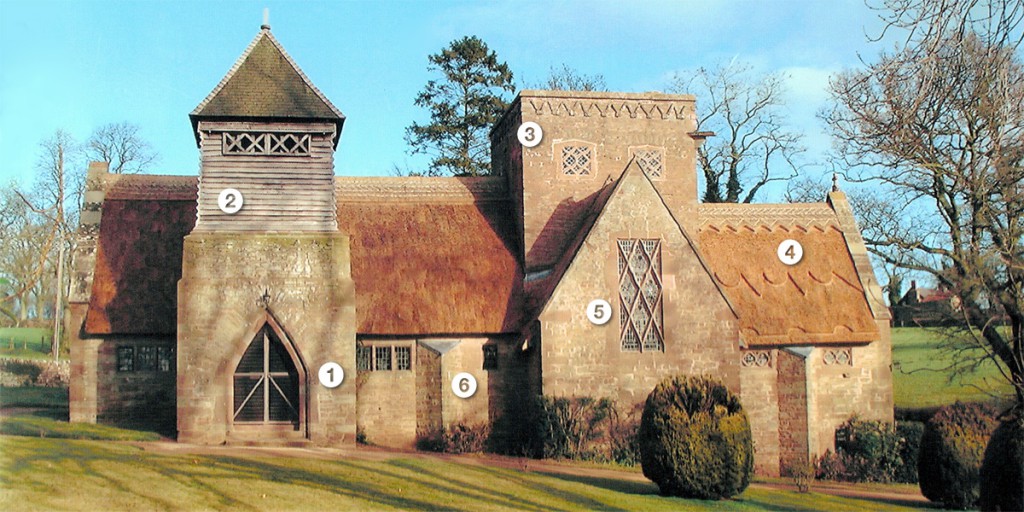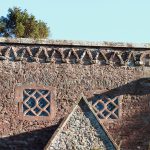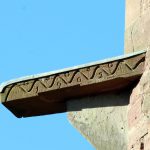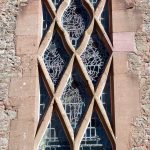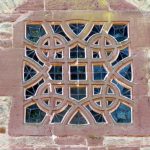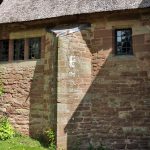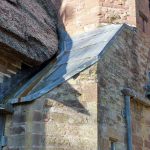Please take time to explore the exterior of the church and the interesting details and textures which make it unique.
Click the titles below to explore the inside of the church:
1 Porch
1 The Porch
The stone porch is simple and unadorned, with a plain semi-circular stone step and arched doorway. Look for the mason’s marks on the stonework around the doorway.
2 Belfry
2 The Belfry
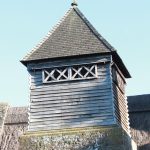 The oak framed belfry is clad in oak boarding and topped with a cedar wood shingled roof. There are simple latticed openings below the eaves and scalloped stop boards at the corners.
The oak framed belfry is clad in oak boarding and topped with a cedar wood shingled roof. There are simple latticed openings below the eaves and scalloped stop boards at the corners.
There are two bells within an oak bell frame. Both were cast by John Taylor and Company, of Loughborough, in 1902, probably using the metal from the disused church bells. The larger bell carries the wording “Not in words but with my voice will I sing praise to my Lord“.
3 The Crossing Tower
3 The Crossing Tower
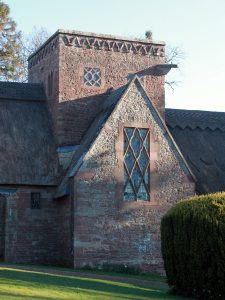 The crossing tower is shorter than would be found in a traditional church and has been described as ‘blunt’. While it is not imposing on the outside, it has a dramatic effect on the interior.
The crossing tower is shorter than would be found in a traditional church and has been described as ‘blunt’. While it is not imposing on the outside, it has a dramatic effect on the interior.
In fact, Lethaby’s original drawings show the tower was actually intended to be about eight to ten feet shorter and would have been only marginally higher than the roof line. While the architect was absent his assistant, Randall Wells, raised it to its current height, apparently without authorisation, with a subsequent increase in costs. This may seem an odd thing to have done but is completely in accord with the principles of the Arts and Crafts Movement, which encouraged freedom of expression in those involved in the project.
Look carefully at the simple chevron stonework details at the head of the tower and the careful carving on the rainwater chute. This detail is thought to have originated from a study Lethaby made of a German castle.
4 Thatched roof
4 Thatched roof
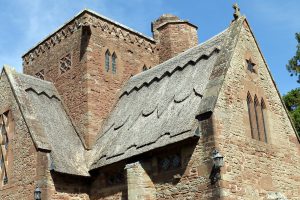 Lethaby’s drawings show that the original plan was for the roof to be of either tiles or slate on a timber structure supported by stone arches. At some point he changed his mind and opted for thatch over poured concrete.
Lethaby’s drawings show that the original plan was for the roof to be of either tiles or slate on a timber structure supported by stone arches. At some point he changed his mind and opted for thatch over poured concrete.
Although not common in Herefordshire, thatch was a favourite roofing material for many Arts and Crafts architects. It was viewed as natural, traditional, easily available and (at the time) cheap. On the down-side, it is susceptible to fire and many contemporary Arts and Crafts buildings which opted for this roofing method, suffered serious fires and were subsequently re-roofed using other materials. All Saints’ is one of only a few Arts and Crafts buildings to have retained its original thatched roof, which may be down to the protection afforded by the concrete understructure.
Re-thatching in Norfolk and French reed was carried out in 2000 to the architects original details.
5 Transepts
5 Transepts
The transepts are very simple and undecorated, with the exception of the south and north windows, which are fine examples of ornamental tracery.
6 Stonework
6 Stonework
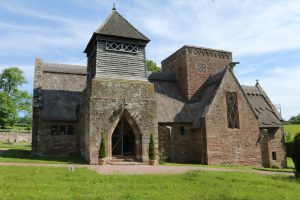 Almost the entire building is built of two types of local Herefordshire sandstone; grey grit sandstone and red sandstone. They are mixed together randomly, both in the rubble walls, window tracery Ornamental stonework, dressings and voussoirs A wedge-shaped or tapered stone used to construct an arch. Any suggestion of a pattern in the arrangement is coincidental. The red sandstone was quarried locally at Caplar Quarry and is the same stone as once used on the west front of Hereford Cathedral.
Almost the entire building is built of two types of local Herefordshire sandstone; grey grit sandstone and red sandstone. They are mixed together randomly, both in the rubble walls, window tracery Ornamental stonework, dressings and voussoirs A wedge-shaped or tapered stone used to construct an arch. Any suggestion of a pattern in the arrangement is coincidental. The red sandstone was quarried locally at Caplar Quarry and is the same stone as once used on the west front of Hereford Cathedral.
The natural Herefordshire stone is no longer quarried because of lack of demand and inconsistent weathering quality, but notice the variation in colour and texture.
The triangular strip buttresses, with their lead caps, are very unusual but blend so well with the overall form of the building. Notice the very different design of the east buttress adjacent to the vestry door. Lethaby wrote a book on leadwork in 1893. A fine example of this craft is visible on the guttering above the north doorway which leads down to the old boiler house.

